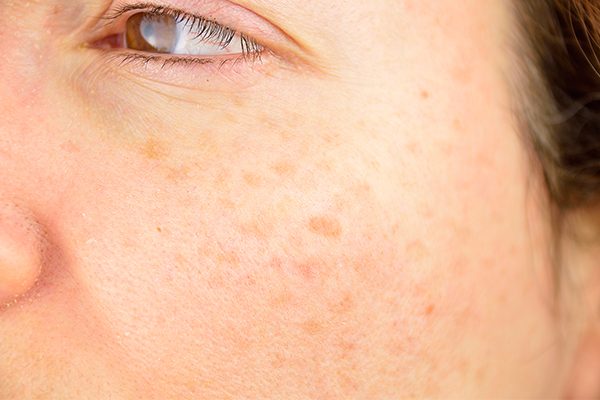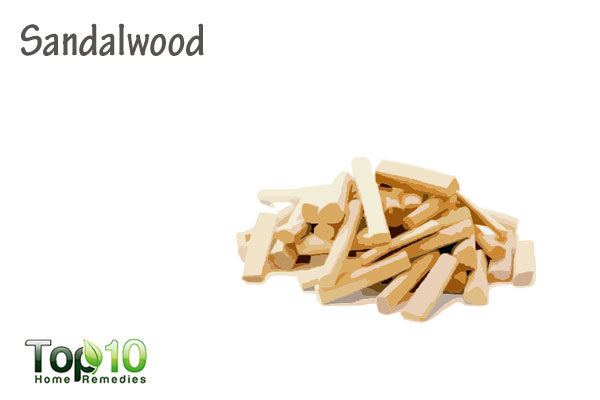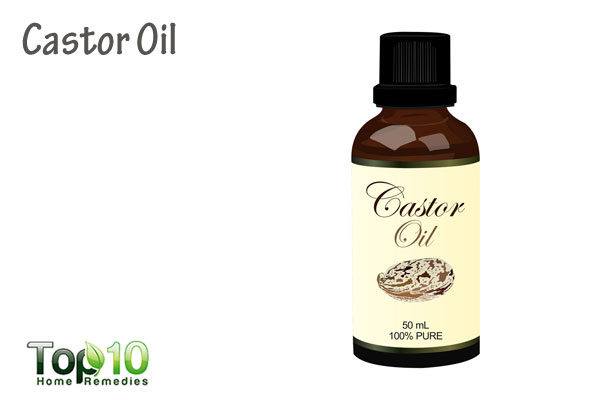Age spots are flat and oval areas of tan,
brown, or black color on the surface of your skin. These spots are
caused by excess production of melanin, which can lead to the
accumulation of melanin in the keratinocytes (epidermal skin cells).
Also known as liver spots or solar lentigines, age spots can give an uneven appearance to your skin complexion.
Although associated with progressing age as a critical factor, age spots can develop as a result of damage caused by prolonged exposure to the sun.[1] The increased production of melanin induced by UV light accumulates and takes the form of an age spot.
Although age spots are painless and harmless, they are undesirable.

There are some standard medical prescriptions and procedures for treating age spots.
As topical treatments enhance the sensitivity of your skin towards sunlight-induced damage, it is recommended to wear sunscreen at all times.
Creams containing retinoids, glycolic acid, deoxyarbutin, alpha hydroxy acid, and kojic acid are used to treat age spots.
Fortunately, some natural home remedies can help you tackle these age spots without spending a fortune.[2]
Read below to check some home remedies to lessen the appearance of your age spots without any complications.
The antioxidant nature of lycopene can dampen the oxidative damage done to the skin upon exposure to UV light.[5] Also, it can smoothen the skin texture and give you glowing skin.

Studies have shown that skin treated with lycopene showed a 10-fold higher antioxidant activity than untreated skin.[3][4]
The acidic nature of tomato offers bleaching properties, helping to reduce the appearance of not only age spots but also skin freckles and blemishes.
Vitamin C is an active depigmenting agent. It can reduce the effects of photoaging and can also prevent sunburn and erythema.[8]
Topical application of vitamin C can induce collagen synthesis and can accelerate repair and regeneration in skin tissue. Vitamin E accentuates the potential of vitamin C fourfold when used in a combination.[7]
The bleaching property of the juice from citrus fruits such as lemons or oranges can be exploited to reduce the appearance of existent dark spots.
A study conducted on hairless mice corroborated the role of vitamin E on inhibiting the damage caused by UV irradiation, less incidence of skin cancer, and reduced pigmentation.[9]

The conjunctive use of vitamin C and vitamin E has proved to work best for protection against damage induced by sunlight.[10]
Regular use of aloe vera gel scrapes off dead skin cells, encourages the growth of new, healthy cells and adds freshness and youth to the skin. It can lighten and possibly remove age spots.

A study has supported the protective effect of aloe vera against radiation damage to the skin.[11]
Aloe vera has shown positive results in diminishing the appearance of wrinkles and reducing erythema.[12]
A study has observed an apparent whitening effect on the skin after three months when treated with lactic acid augmented with 1% ascorbic acid. However, the whitening effect on the age spots was only modest.

Additionally, yogurt keeps the skin moisturized and fresh looking.[13][14]
Many studies support the role of curcumin to heal various dermatologic diseases.

The healing properties of turmeric are used to treat skin problems and even treat skin pigmentation.[16][17]
No wonder sandalwood essential oil is a constituent of many cosmetic products.[19][20]

Buttermilk also helps restore and rejuvenate the skin.

Pure honey is effective against microbes that attack the skin. It protects against UV-induced DNA damage and promotes tissue regeneration.[21]
Besides this, the application of pure honey can lighten your age spots by acting as an exfoliator. Honey can effectively moisturize your skin and rejuvenate it to look young and fresh.
The unusually high content of ricinoleic acid allows castor oil to penetrate deep into the skin, preventing water loss, which promotes the healing process.[22]

You can limit exposure to the sun by taking the following steps:
Because changes in skin color that look odd may indicate melanoma (a severe form of skin cancer), they must be medically evaluated prior to treatment.
A skin pigmentation on the skin requires medical evaluation when it:
Although the standard treatment methods of topical applications and medical procedures can reduce the appearance of age spots, they may be expensive over time.
However, you can diminish your spots without heading to a doctor’s clinic with the help of the simple home remedies discussed above.
Source Click here
Also known as liver spots or solar lentigines, age spots can give an uneven appearance to your skin complexion.
Although associated with progressing age as a critical factor, age spots can develop as a result of damage caused by prolonged exposure to the sun.[1] The increased production of melanin induced by UV light accumulates and takes the form of an age spot.
Although age spots are painless and harmless, they are undesirable.

Contents
Causes of Age Spots
The possible causes behind developing age spots are:- Exposure to sunlight (UV radiation), resulting in excess production of melanin that can lead to a darker skin tone
- Aging of skin in people older than 50
- Excessive use of tanning lamps and tanning beds
The Appearance of Age Spots
Age spots appear on the skin as:- Flat, circular to oval markings of intense pigmentation
- Tanned to black colored
- Painless[1]
- Located on areas with maximum exposure to the sun, such as the face, shoulder, upper back, back of the hands, and top of the feet
Treating Age Spots
Age spots are painless and do not pose any health risks. However, for cosmetic reasons, a considerable amount of time and expenses is spent on procedures that, though effective at times, come with a range of side effects.There are some standard medical prescriptions and procedures for treating age spots.
Topical Creams and Lotions
Topical creams and lotions reduce the texture of the spot over a while. It takes a lot of time and patience for these to show effects.As topical treatments enhance the sensitivity of your skin towards sunlight-induced damage, it is recommended to wear sunscreen at all times.
Creams containing retinoids, glycolic acid, deoxyarbutin, alpha hydroxy acid, and kojic acid are used to treat age spots.
Medical Procedures
- Laser therapy: A laser beam is used to destroy the cells producing melanin without damaging the surface of the skin
- Chemical peels: Chemical sheets are used to remove the old spotted layer of skin.
- Cryotherapy: Liquid nitrogen is used to freeze off the age spot and destroy the pigmented skin.
- Microdermabrasion: The surface skin cells are removed using either a diamond-or crystal-tipped brush to erode the spotted skin surface.
Fortunately, some natural home remedies can help you tackle these age spots without spending a fortune.[2]
Read below to check some home remedies to lessen the appearance of your age spots without any complications.
Alternative Cures and Remedies for Age Spots
Note:
Here are some home remedies for age spots.- Always do a patch test on a small area of skin to check how your skin reacts to the remedy.
- Bear in mind that natural remedies work slowly over time, so you need to be patient and persistent. It may take several days or longer to notice an improvement, depending on the severity of the condition.
- Do not use home remedies for age spots that are irregular, accompanied by redness, itching. and bleeding. These spots require medical intervention to check for the possibility of melanoma.
1. Apply Tomato Juice on the Affected Area
Tomatoes contain a carotenoid pigment called lycopene.The antioxidant nature of lycopene can dampen the oxidative damage done to the skin upon exposure to UV light.[5] Also, it can smoothen the skin texture and give you glowing skin.

Studies have shown that skin treated with lycopene showed a 10-fold higher antioxidant activity than untreated skin.[3][4]
The acidic nature of tomato offers bleaching properties, helping to reduce the appearance of not only age spots but also skin freckles and blemishes.
- Rub a slice of tomato on the affected area. Allow the juice to settle on the spot for 20 minutes. Rinse it off with cold water. Repeat once or twice a day.
- Mix equal amounts of tomato juice and honey. Apply the mixture on the affected skin. Wait for about 10 minutes, and then rinse it off with fresh water. Do this once or twice daily.
2. Vitamin C Sources can Provide Relief
Vitamin C is a source of antioxidants that potentially destroy oxidants and protect your skin from free radical-induced damage caused primarily by ultraviolet radiation.[6]Vitamin C is an active depigmenting agent. It can reduce the effects of photoaging and can also prevent sunburn and erythema.[8]
Topical application of vitamin C can induce collagen synthesis and can accelerate repair and regeneration in skin tissue. Vitamin E accentuates the potential of vitamin C fourfold when used in a combination.[7]
The bleaching property of the juice from citrus fruits such as lemons or oranges can be exploited to reduce the appearance of existent dark spots.
- Apply the juice of a lemon or orange to the affected area. Let it sit on your skin for 10 minutes. Rinse it off with warm water. Do this twice daily.
Note: Avoid going out in the sun after you have applied lemon juice.
3. Up Your Vitamin E Intake
Vitamin E works as an antioxidant and can potentially reverse UV-induced damage on the skin.A study conducted on hairless mice corroborated the role of vitamin E on inhibiting the damage caused by UV irradiation, less incidence of skin cancer, and reduced pigmentation.[9]

The conjunctive use of vitamin C and vitamin E has proved to work best for protection against damage induced by sunlight.[10]
- Massage vitamin E oil on the affected skin for 10 to 15 minutes twice daily. Do this for a few weeks to reduce your uneven skin tone.
- Extract the contents of two vitamin E capsules and add 1 teaspoon of castor oil to it. Mix thoroughly. Apply the mixture on the affected areas before going to bed. Leave it on overnight and rinse it off the next morning. Use this remedy daily.
- Try to include vitamin E sources in your diet. Some sources are nuts, whole grains, olive oil, spinach, and sunflower oil.
4. Aloe Vera Gel can be Beneficial
Abundant with vitamin A, C, and E, aloe vera has anti-inflammatory and moisturizing properties.Regular use of aloe vera gel scrapes off dead skin cells, encourages the growth of new, healthy cells and adds freshness and youth to the skin. It can lighten and possibly remove age spots.

A study has supported the protective effect of aloe vera against radiation damage to the skin.[11]
Aloe vera has shown positive results in diminishing the appearance of wrinkles and reducing erythema.[12]
- Peel the aloe vera leaf and extract the gel.
- Rub the gel onto your age spots.
- Let it sit on your skin for 1 hour or more. You can then rinse your skin.
- Repeat this twice a day.
5. Moisturize Your Skin with Yogurt
The lactic acid content in yogurt aids in bleaching the skin and enables the sloughing off of the dead skin cells, reducing the visibility of dark spots.A study has observed an apparent whitening effect on the skin after three months when treated with lactic acid augmented with 1% ascorbic acid. However, the whitening effect on the age spots was only modest.

Additionally, yogurt keeps the skin moisturized and fresh looking.[13][14]
- Apply some plain yogurt directly on the spots. Allow it to dry on its own for about 20 minutes before rinsing it off with cold water. Do this two or three times a day.
- As an alternative, you can apply a DIY face mask two to three times a week.
- Mix well 1 tablespoon of plain yogurt, 2 tablespoons of ground oatmeal, and 1 teaspoon of fresh lemon juice.
- Apply the mixture on the spots and let it sit for 30 minutes.
- Rinse it off with cold water.
6. Use Turmeric Face Mask
A popular remedy in Ayurvedic medicine, turmeric has been extolled since ages for its anti-inflammatory, antimicrobial, antioxidant, and anti-neoplastic properties.[15]Many studies support the role of curcumin to heal various dermatologic diseases.

The healing properties of turmeric are used to treat skin problems and even treat skin pigmentation.[16][17]
- To 2 teaspoons of turmeric powder, add a little milk. You can also add a little lemon juice.
- Apply the mixture on the affected areas.
- Leave it on for 20 minutes, and then rinse off with lukewarm water.
- Do this two to three times a week.
7. Reap the Benefits of Sandalwood
Sandalwood oil exhibits antiaging, anticarcinogenic, antiproliferative, and antibacterial activities.[18] Its anti-aging properties can help reduce the pigmentation on your skin.No wonder sandalwood essential oil is a constituent of many cosmetic products.[19][20]

- Mix 2 tablespoons of sandalwood powder, 2 tablespoons of rose water, and a few drops of lemon juice to make a paste. Apply the paste on the affected area until it dries. Rinse it off with cold water. Repeat this two to three times a week until the blemishes fade away.
- To a few drops of sandalwood essential oil, add a few drops of sweet almond oil to dilute it. Apply the mixture on the affected areas.
8. Buttermilk is Worth a Try
Like yogurt, buttermilk contains lactic acid bacteria. The mild bleaching action of buttermilk gently exfoliates the pigmented and sun-damaged skin, to reveal healthy skin with less noticeable spots on the surface.[13]Buttermilk also helps restore and rejuvenate the skin.

- Apply plain buttermilk directly on the affected areas. Let it sit for 10 minutes before rinsing it off with water. Repeat this two to three times daily as needed.
- Alternatively, mix 4 teaspoons of buttermilk and 2 teaspoons of tomato juice. Apply this mixture on the affected skin. Let it sit for 10 minutes before rinsing it off with water. Repeat this twice daily.
9. Smear Honey on Your Skin
Honey is known to have potent antimicrobial activity due to its high sugar content.Pure honey is effective against microbes that attack the skin. It protects against UV-induced DNA damage and promotes tissue regeneration.[21]
Besides this, the application of pure honey can lighten your age spots by acting as an exfoliator. Honey can effectively moisturize your skin and rejuvenate it to look young and fresh.
- Blend honey and tomato juice into a paste. Apply this paste to your spots using a cotton ball. Rinse it off after it has dried.
- Apply about 1/2 teaspoon of raw honey to your skin and massage in circular motions. Leave it on your face for at least 30 minutes. Rinse it off with warm water.
10. Massage Using Castor Oil
Castor oil is known for its antioxidant and nourishing abilities that can help heal a variety of skin conditions, including age spots and pigmentation.The unusually high content of ricinoleic acid allows castor oil to penetrate deep into the skin, preventing water loss, which promotes the healing process.[22]

- Dab a little oil on the spots using a cotton swab.
- Massage the area for 1 to 2 minutes or until the oil is thoroughly absorbed into the skin.
- Leave it on for a few hours, and then rinse your skin.
- Repeat this twice each day, once in the morning and once at night.
Preventing Age Spots
Age spots can develop as a result of damage induced by increased exposure to the sun and manifest usually when the skin starts aging.You can limit exposure to the sun by taking the following steps:
- Avoid going out in the sun during midday, when the sunlight is intense.
- Wear clothes that can protect your body from sun exposure. Use long-sleeved tops and shirts, hats, caps, and full-length pants and skirts.
- Always wear a good-quality sunscreen 30 minutes before you go out in the sun. Use a sunscreen that has:
- Broad-spectrum protection against both UVA and UVB
- An SPF rating greater than 30
- Resistance to water
When to See a Doctor
Usually, dark spots are not a significant cause of concern, but an age spot that looks suspicious and irregular calls for medical attention.Because changes in skin color that look odd may indicate melanoma (a severe form of skin cancer), they must be medically evaluated prior to treatment.
A skin pigmentation on the skin requires medical evaluation when it:
- Rapidly increases in size
- Is irregular in shape
- Is accompanied by redness, tenderness, itching, or bleeding
Final Word
Age spots result from a combination of natural aging factors in conjunction with exposure to sunlight, but irregular age spots call for medical attention as they can be indicative of skin cancer.Although the standard treatment methods of topical applications and medical procedures can reduce the appearance of age spots, they may be expensive over time.
However, you can diminish your spots without heading to a doctor’s clinic with the help of the simple home remedies discussed above.
Source Click here
Comments
Post a Comment